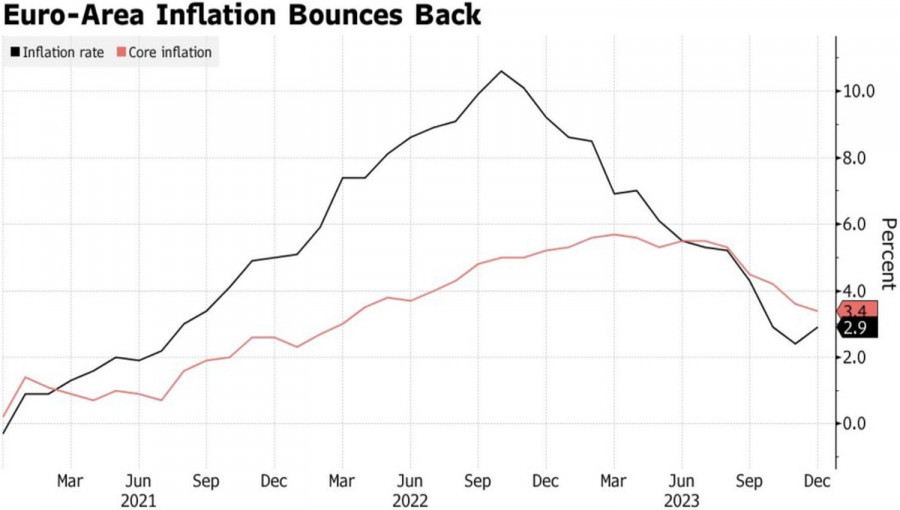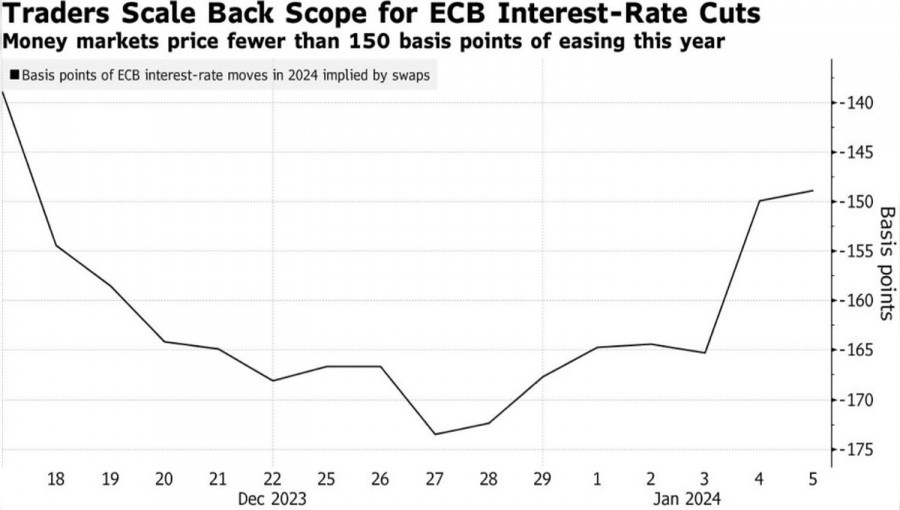
EUR/USD bulls failed to benefit from the acceleration of European consumer prices from 2.3% to 2.9% year-on-year. This growth was based on base effects – at the end of 2022, Germany's decision to pay the population's electricity bills reduced the impact of energy goods on the CPI. However, the December spike should be seen as a temporary phenomenon. The trend towards a decrease in the indicator remains in force, especially since core inflation slowed down from 3.6% to 3.4%, service inflation remained at 4%, and goods prices decreased by 2.5%.
Dynamics of European Inflation

-Eurozone consumer price statistics, combined with the revision of the currency bloc's business activity data for December upwards, led the futures market to reduce the chances of a cut in the ECB's deposit rate from 174 basis points to 150 basis points in 2024. If it were solely about the European Central Bank, the revision of investors' views could have played into the hands of EUR/USD. However, the futures market also expects other regulators, including the Federal Reserve, to slow down the easing of monetary policy more than at the end of December. This leads to a strengthening of the U.S. dollar against the major world currencies.
Indeed, if the reduction of the federal funds rate to 4% by 150 basis points is already factored into the quotes of U.S. stock indices, and in reality, the Federal Reserve reduces the cost of borrowing by only 75-100 basis points, the S&P 500 should undergo a serious correction. As a result, EUR/USD will suffer too.
Dynamics of the Presumed Reduction in the ECB's Deposit Rate

It cannot be said that European business activity and inflation data are irrelevant. However, the transition of central banks, led by the Federal Reserve, from tightening monetary policy in 2021-2023 to easing it in 2024-2025, has a much greater impact on financial markets than Eurozone macro statistics. Investors closely follow the words and actions of the Federal Reserve. It makes decisions based on new data. That's why December's non-farm payroll statistics are of crucial importance.
In this respect, the growth of non-farm payrolls by 216,000, the acceleration of average earnings to 0.4% month-on-month and 4.1% year-on-year, and the unemployment rate remaining at the previous mark of 3.7% indicate the strength of both the labor market and the economy. Instead of a soft landing, the U.S. GDP risks accelerating again. This will force the Federal Reserve to either think about keeping the federal funds rate at 5.5% for a long time or resuming the cycle of monetary tightening.

Most likely, after such employment statistics, the futures market will shift expectations of the first reduction in borrowing costs from March to a later period, which will support the U.S. dollar.
Technically, on the daily chart of EUR/USD, the correction to the upward trend continues. A close below the blue moving average will testify to the seriousness of the bears' intentions, increase the risks of breaking the trend, and allow building up previously formed short positions in the euro towards $1.081 and $1.0785.